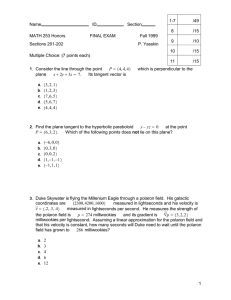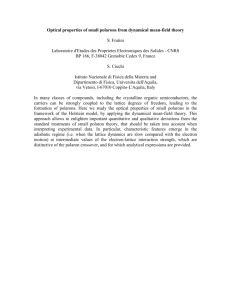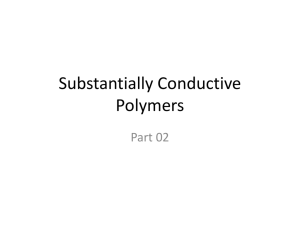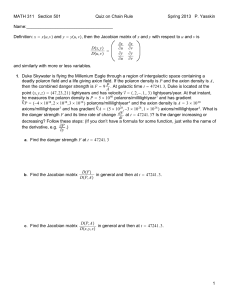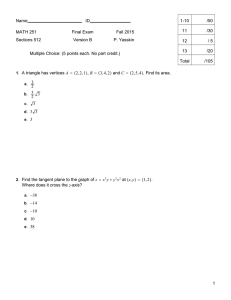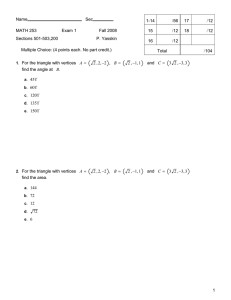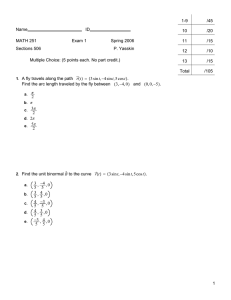Accuracy of second order perturbation theory in the Please share
advertisement
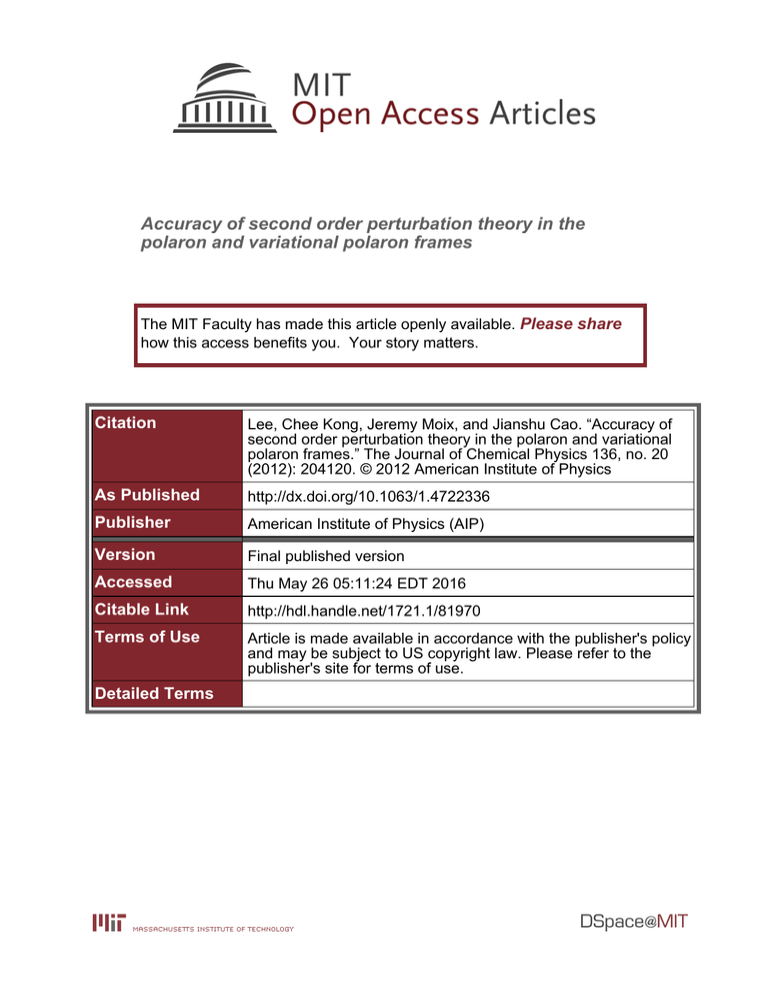
Accuracy of second order perturbation theory in the
polaron and variational polaron frames
The MIT Faculty has made this article openly available. Please share
how this access benefits you. Your story matters.
Citation
Lee, Chee Kong, Jeremy Moix, and Jianshu Cao. “Accuracy of
second order perturbation theory in the polaron and variational
polaron frames.” The Journal of Chemical Physics 136, no. 20
(2012): 204120. © 2012 American Institute of Physics
As Published
http://dx.doi.org/10.1063/1.4722336
Publisher
American Institute of Physics (AIP)
Version
Final published version
Accessed
Thu May 26 05:11:24 EDT 2016
Citable Link
http://hdl.handle.net/1721.1/81970
Terms of Use
Article is made available in accordance with the publisher's policy
and may be subject to US copyright law. Please refer to the
publisher's site for terms of use.
Detailed Terms
Accuracy of second order perturbation theory in the polaron and variational
polaron frames
Chee Kong Lee, Jeremy Moix, and Jianshu Cao
Citation: J. Chem. Phys. 136, 204120 (2012); doi: 10.1063/1.4722336
View online: http://dx.doi.org/10.1063/1.4722336
View Table of Contents: http://jcp.aip.org/resource/1/JCPSA6/v136/i20
Published by the American Institute of Physics.
Additional information on J. Chem. Phys.
Journal Homepage: http://jcp.aip.org/
Journal Information: http://jcp.aip.org/about/about_the_journal
Top downloads: http://jcp.aip.org/features/most_downloaded
Information for Authors: http://jcp.aip.org/authors
Downloaded 24 Oct 2012 to 18.74.6.138. Redistribution subject to AIP license or copyright; see http://jcp.aip.org/about/rights_and_permissions
THE JOURNAL OF CHEMICAL PHYSICS 136, 204120 (2012)
Accuracy of second order perturbation theory in the polaron
and variational polaron frames
Chee Kong Lee,1,a) Jeremy Moix,2,3 and Jianshu Cao2,b)
1
Centre for Quantum Technologies, National University of Singapore, 117543 Singapore
Department of Chemistry, Massachusetts Institute of Technology, Cambridge, Massachusetts 02139, USA
3
School of Materials Science and Engineering, Nanyang Technological University, 639798 Singapore
2
(Received 1 February 2012; accepted 11 May 2012; published online 31 May 2012)
In the study of open quantum systems, the polaron transformation has recently attracted a renewed
interest as it offers the possibility to explore the strong system-bath coupling regime. Despite this
interest, a clear and unambiguous analysis of the regimes of validity of the polaron transformation
is still lacking. Here we provide such a benchmark, comparing second order perturbation theory
results in the original untransformed frame, the polaron frame, and the variational extension with
numerically exact path integral calculations of the equilibrium reduced density matrix. Equilibrium
quantities allow a direct comparison of the three methods without invoking any further approximations as is usually required in deriving master equations. It is found that the second order results in
the original frame are accurate for weak system-bath coupling; the results deteriorate when the bath
cut-off frequency decreases. The full polaron results are accurate for the entire range of coupling for
a fast bath but only in the strong coupling regime for a slow bath. The variational method is capable
of interpolating between these two methods and is valid over a much broader range of parameters.
© 2012 American Institute of Physics. [http://dx.doi.org/10.1063/1.4722336]
I. INTRODUCTION
In many open quantum systems, the coupling between
the system and the bath can be considered as a small parameter. In this case, the application of second order perturbation
leads to a master equation of Redfield or Lindblad type.1 Their
numerical implementation is straightforward and not computationally expensive. However, for many physical systems of
current interest it has been shown that the weak coupling approximation is not justified. One example is the energy transfer process in photosynthetic complexes where the magnitude
of the system-bath coupling is comparable to the electronic
couplings.2–5 There are only a few non-perturbative techniques to obtain the numerically exact dynamics; examples
include the hierarchy master equation,6, 7 the quasi-adiabatic
propagator path integral (QUAPI),8, 9 and the multiconfiguration time-dependent Hartree approach.10–12 However, these
methods are computationally demanding and also not trivial
to implement.
Recently, a polaron transformed second order master
equation13–18 has been derived to study the dynamics of open
quantum systems at strong coupling. This approach transforms the total Hamiltonian into the polaron frame such that
the system Hamiltonian is dressed by a polaron. The master equation is then obtained by applying perturbation theory to the transformed system-bath interaction term. This approach extends the regime of validity of the master equation
to stronger system-bath coupling, provided that the electronic
couplings (or tunneling matrix elements) are small compared
to the typical bath frequency. When this condition is not fula) Electronic mail: cqtlck@nus.edu.sg.
b) Electronic mail: jianshu@mit.edu.
0021-9606/2012/136(20)/204120/7/$30.00
filled, the polaron is too sluggish to accurately follow the
system motion and the polaron transformation may perform
worse than the standard master equation approach.
In order to partially overcome this difficulty, the variational method has been developed as a generalization of the
polaron transformation.19–22 Instead of performing the full
transformation, the variational polaron approach seeks for an
optimal amount of transformation, depending on the properties of the bath. Thus it is able to interpolate between the
strong and weak coupling regimes and to capture the correct behavior over a much broader range of parameters. Both
the polaron and variational master equations have the attractive feature of being computationally economic (they have the
same computational complexity as the Redfield equation) and
are therefore suitable for studying large systems.
However, a thorough assessment of the accuracy of
second order perturbation theory (2nd-PT) in the polaron and
variational polaron frames is still lacking. It is not exactly
clear how the accuracy depends on the properties of the bath,
namely, the bath relaxation time and the coupling strength.
One of the main goals of this work is to provide such a
benchmark. Instead of studying the dynamics, here we focus
on the equilibrium density matrix. Focusing on this quantity
offers two key advantages. First, in the equilibrium case the
second order perturbation is the only approximation involved.
In the derivation of second order master equations, additional
approximations generally must be invoked, such as factorized
initial conditions and the Born-Markov approximation. These
additional restrictions prevent a clear assessment of the isolated role of second order perturbation theory and the merits
of the polaron transformation (Refs. 13–15, and 21 avoided
the Born-Markov approximation though). Thus studying
the equilibrium density matrix offers a direct comparison
136, 204120-1
© 2012 American Institute of Physics
Downloaded 24 Oct 2012 to 18.74.6.138. Redistribution subject to AIP license or copyright; see http://jcp.aip.org/about/rights_and_permissions
204120-2
Lee, Moix, and Cao
J. Chem. Phys. 136, 204120 (2012)
of the various perturbation methods. A second advantage
of studying the equilibrium state is that it is much easier to
obtain numerically exact results. Therefore, we are able to
systematically explore a large range of the parameter space
that is often not possible with other exact treatments of the
dynamics.
In Sec. II A, the details of the spin-boson model used in
the remainder of the text are outlined. Following this, the polaron transformation and its variational extension are applied
to the Hamiltonian in Sec. II B. In Sec. II C, the second-order
corrections to the equilibrium reduced density matrix are derived in the original, polaron, and variational polaron frames.
In the ensuing section, results for the various perturbation theories are compared with exact numerical results from path integral calculations over a broad range of the parameter space.
As expected, it is found that the second-order results in the
original frame are accurate for small system-bath coupling
and fast bath. The full polaron method is valid for the entire range of coupling for a fast bath. But for a slow bath, it is
only accurate in the strong coupling regime. The variational
method is capable of interpolating between these two methods
and provides a much more accurate description.
II. THEORY
A. Spin-boson model
The spin-boson model is a paradigm for the study of
quantum dissipative systems. It has been used to investigate the energy transfer in light harvesting systems,23, 24
the problem of decoherence in quantum optics,25 tunneling phenomena in condensed media,26, 27 and quantum phase
transitions.28–30 The spin-boson model consists of a two-level
system coupled to a bath of harmonic oscillators. Its Hamiltonian can be written as (we set ¯ = 1)
Ĥtot
=
B. Polaron and variational polaron transformations
The polaron transformation is generated by the unitary
operator
fk †
Û = exp σ̂z
b̂ − b̂k ,
(3)
ωk k
k
which displaces the bath oscillators in the positive or negative
direction depending on the state of the two-level system. The
parameter fk determines the magnitude of the displacement
for each mode. Setting fk = gk corresponds to the full polaron
transformation, whereas fk = 0 corresponds to no transformation. The variational method allows us to determine an optimal value of fk that lies in between these two limits, 0 ≤ fk
≤ gk , making the transformation valid over a wider range of
parameters.
Applying the transformation to the total Hamiltonian, we
have
Û †
Ĥtot = Û Ĥtot
= Ĥ0 + ĤI ,
where the total free Hamiltonian is Ĥ0 = ĤS + ĤB . The
transformed system Hamiltonian is given by
fk
R
σ̂x +
ĤS = σ̂z +
(fk − 2gk ),
2
2
ωk
k
and the bath Hamiltonian remains unaffected, ĤB
†
= k ωk b̂k b̂k . The transformed interaction Hamiltonian
becomes
J (ω) =
1 ω3 −ω/ωc
γ e
,
2 ωc3
(2)
ĤI = σ̂x V̂x + σ̂y V̂y + σ̂z V̂z ,
(5)
V̂x =
2
2
− 2B),
(D̂ + D̂−
4 +
(6)
V̂y =
2
2
(D̂ − D̂+
),
4i −
(7)
V̂z =
†
(gk − fk ) b̂k + b̂k ,
(8)
where
†
†
ωk b̂k b̂k + σ̂z
gk b̂k + b̂k , (1)
σ̂z + σ̂x +
2
2
k
k
where σ i (i = x, y, z) are the usual Pauli matrices, is the
energy splitting between the two levels, and is the tunneling matrix element. The bath is modeled as a set of harmonic
oscillators labeled by their frequencies, ωk , and couplings to
the two-level system denoted by gk .
The properties of the harmonic bath are
completely determined by the spectral density, J (ω) = π k gk2 δ(ω − ωk ).
Throughout the paper, we use a super-ohmic spectral density
with an exponential cut-off,
k
and D̂± is the product of displacement operators, D̂±
±
fk
†
(b̂ −b̂ )
= e k ωk k k . The tunneling rate is renormalized by the
expectation value of the bath displacement operators, R
= B, where
2
B = D̂±
ĤB =
= exp −2
2 −β ĤB
trB [D̂±
e
]
(9)
trB [e−β ĤB ]
f2
k
where γ is the system-bath coupling strength and has the dimension of frequency. The cut-off frequency is denoted by
ωc , and its reciprocal governs the relaxation time of the bath,
τ ∝ ω1c .
(4)
k
ωk2
coth(βωk /2) .
(10)
Note that the interaction term is constructed such that
ĤI H0 = 0.
Following Silbey and Harris,19, 20 we use the Bogoliubov
variational theorem to determine the optimal values for the set
Downloaded 24 Oct 2012 to 18.74.6.138. Redistribution subject to AIP license or copyright; see http://jcp.aip.org/about/rights_and_permissions
204120-3
Lee, Moix, and Cao
J. Chem. Phys. 136, 204120 (2012)
{fk }. We first compute the Bogoliubov-Feynman upper bound
on the free energy, AB ,
1
AB = − ln trS+B [e−β Ĥ0 ] + ĤI Ĥ0 .
β
where
 =
(11)
dβ
fk = gk F (ωk );
(12)
−1
2R
coth(βωk /2) tanh(βη/2)
F (ωk ) = 1 +
, (13)
ωk η
where η = 2 + 2R .
In the continuum limit, the renormalization constant can
be written as
∞
dω J (ω)
2
B = exp −2
F (ω) coth(βω/2) . (14)
π ω2
0
n,m=x,y,z
ZS(0)
−β ĤS
= trS [e
];
trB [e
trS+B
]
[e−β Ĥtot ]
(15)
.
Expanding the operator e−β Ĥtot up to second order in ĤI , we
have
β
−β Ĥtot
−β Ĥ0
e
≈e
dβ eβ Ĥ0 ĤI e−β Ĥ0
1−
0
+
β
dβ
0
β
β Ĥ0
dβ e
ĤI e
−(β −β )Ĥ0
−β Ĥ0
ĤI e
.
0
(16)
The above expansion is similar to the Dyson expansion, with
β treated as imaginary time.
Since ĤI Ĥ0 = 0, the leading order correction to ρ̂S is
of second order in ĤI . Inserting the above expression into
Eq. (15) and keeping terms up to the second order in ĤI , the
system equilibrium state can be approximated as31–33
dβ Cnm (β − β )
−β )ĤS
ZS(2)
σ̂m e−β
ĤS
,
= trS [Â],
(18)
The non-vanishing bath correlation functions are
Czy (τ ) = −Cyz (τ )
= iR
(20)
sinh 12 (β − 2τ )ω
dω J (ω)
F (ω)[1 − F (ω)]
,
π ω
sinh(βω/2)
∞
0
(21)
Cxx (τ ) =
C. Second order perturbation theory
ρ̂S =
β
and Cnm (τ ) is the bath correlation function in imaginary time,
trB eτ ĤB V̂n e−τ ĤB V̂m e−β ĤB
.
(19)
Cnm (τ ) =
trB [e−β ĤB ]
2R φ(τ )
(e
+ e−φ(τ ) − 2),
8
(22)
2R φ(τ )
− e−φ(τ ) ),
(e
8
(23)
Cyy (τ ) =
−β Ĥtot
0
× e(β −β)ĤS σ̂n e(β
Since F(ω) is also a function of B, the above equation must be
solved self-consistently.
This section is dedicated to finding the second-order correction to the equilibrium state of the system. The exact equilibrium reduced density matrix can be formally written as
0
Since ĤI Ĥ0 = 0 by construction, the upper bound is solely
determined by the free Hamiltonian. The variational theorem
states that AB ≥ A where A is the true free energy of Htot .
Therefore, we want to make this bound as small as possible
B
= 0. The minby minimizing AB with respect to {fk }, i.e., dA
dfk
imization condition leads to
β
∞
Czz (τ ) =
0
cosh 12 (β − 2τ )ω
dω
J (ω)[1 − F (ω)]2
,
π
sinh(βω/2)
(24)
where
∞
φ(τ ) = 4
0
cosh 12 (β − 2τ )ω
dω J (ω)
2
. (25)
F (ω)
π ω2
sinh(βω/2)
It is useful at this point to analyze the behavior of the
perturbation theory at strong coupling in the polaron frame.
As seen from Eq. (14), when γ → ∞ then B → 0 and the
system becomes incoherent since the coherent tunneling element vanishes. At the same time, F(ω) → 1 as B → 0 so that
all of the above correlation functions vanish, and hence also
the second-order correction to ρ̂S . Therefore in this limit, the
equilibrium density matrix is only determined by the energy
splitting of the two levels, ρ̂S ∝ exp(− 2 β σ̂z ).
The full polaron result can be conveniently obtained by
setting F(ω) = 1; the only non-vanishing correlation functions
in this case are Cxx and Cyy . The opposite limit of F(ω) = 0
corresponds to performing no transformation and Czz is the
only non-zero correlation function. For comparison, below we
will also include the results from these two limiting cases.
ρ̂S ≈ ρ̂S(0) + ρ̂S(2) + . . . ,
III. RESULTS AND DISCUSSIONS
ρ̂S(0) = e−β ĤS /ZS(0) ,
ρ̂S(2)
=
Â
ZS(0)
ZS(2) −β ĤS
− (0)
,
2 e
ZS
(17)
In this section, we compare the results from 2nd-PT in
the original [F(ω) = 0], the polaron [F(ω) = 1], and the
variational polaron [F(ω) as in Eq. (13)] frames with those
Downloaded 24 Oct 2012 to 18.74.6.138. Redistribution subject to AIP license or copyright; see http://jcp.aip.org/about/rights_and_permissions
204120-4
Lee, Moix, and Cao
FIG. 1. Fast bath, ωc > . Comparison of the approximate methods with
the exact path integral results as a function of the dissipation, γ , for ωc
= 5 and = 3. Plotted are the values of σ̂z from the zeroth-order density
matrix in the polaron frame (light blue crosses) and the variational polaron
frame (dark blue diamonds), as well as from the density matrix in the original
frame with the second-order correction (red dashed line), the polaron frame
(purple empty circles), and the variational polaron frame (solid green line).
The exact path integral results are shown as filled (black) dots.
from numerically exact imaginary time path integral calculations. We compute the expectation value, σ̂z , since it is not
affected by the transformation, Û † σ̂z Û = σ̂z . Therefore,
this quantity allows us to make a direct comparison between
the path integral results, which provide the density matrix
in the original frame, and the (variational) polaron results. Results from the transformed zeroth-order density matrix, ρ̂S(0) ,
which depends only on the renormalized system Hamiltonian
ĤS , are also included. In the original frame, corrections to the
off-diagonal elements of the equilibrium density matrix calculated within the polaron transformation appear already at first
order in perturbation theory. Their computation, however, is
substantially more involved and is a topic of ongoing work.
We first calculate σ̂z as a function of the dissipation
strength for fast, slow, and adiabatic baths, assessing the accuracy of 2nd-PT for different bath cut-off frequencies. We then
conclude this section by presenting phase diagrams of the relative errors of the various methods as functions of the dissipation strength and the bath cut-off frequency. This allows us to
establish the regimes of validity of each approach across the
entire range of bath parameters. Throughout the paper, we set
= 1 and β = 1.
A. Fast bath, ωc > The value of σ̂z is plotted as a function of the dissipation strength, γ , in Fig. 1 for a fast bath, ωc > . First, it can
be seen that the result from the usual 2nd-PT in the original
frame (dashed line) is linearly dependent on γ . While this approach is accurate at small γ , it quickly degrades as the coupling increases. On the other hand, the results from 2nd-PT in
the polaron (empty circles) and the variational polaron (solid
line) frames are in excellent agreement with the exact path
integral result (solid dots) over the entire range of dissipation. The zeroth-order result for σ̂z in the the polaron frame
(crosses) tends to overestimate the correction, whereas the
variational frame result (diamonds) provides at least a qualitatively correct description.
J. Chem. Phys. 136, 204120 (2012)
FIG. 2. Slow bath, ωc < . Comparison of the approximate methods with
the exact path integral results as a function of the dissipation, γ , for ωc
= 1.5 and = 5. Plotted are the values of σ̂z from the zeroth-order
density matrix in the polaron frame (light blue crosses) and the variational
polaron frame (dark blue diamonds), as well as from the density matrix in the
original frame with the second-order correction (red dashed line), the polaron
frame (purple empty circles), and the variational polaron frame (solid green
line). The exact path integral results are shown as filled (black) dots.
B. Slow bath, ωc < Figure 2 displays the opposite case, when the bath is slow
as compared to the tunneling rate, ωc < . At small and intermediate γ , it can be seen that the polaron method with
2nd-PT fails to predict the correct behavior, while the usual
2nd-PT result in the original frame agrees well with the exact result. As with the case of the fast bath, at large γ , the
polaron method provides an accurate description, while the
original frame 2nd-PT breaks down. The variational polaron
method (with 2nd-PT) interpolates between these two methods, providing accurate results over a large range of the dissipation strength. The failure of the full polaron method is due
to the fact that the bath oscillators are sluggish and are not
able to fully dress the system. Therefore, the full polaron displacement is no longer appropriate. It can also be seen that
the second-order correction in the full polaron frame is huge
at small γ (the difference between the crosses and open circles). This should cast doubt on the validity of 2nd-PT in this
case since the perturbative correction should be small.
It can also be observed that there is a discontinuity in
the variational result (both with and without 2nd-PT) at the
critical point of γ ≈ 10.6. The variational approach exhibits
a rather abrupt transition from a small transformation [F(ω)
1] to the full polaron transformation [F(ω) ≈ 1]. This discontinuity, which is an artifact of the transformation rather
than a physical phase transition, has been predicted by Silbey
and Harris19, 20 for a slow bath. The discontinuity comes from
solving the self-consistent equation in Eq. (14). Over a certain
range of dissipation strengths, there exist multiple solutions to
the self-consistent equation. According to the variational prescription, the solution with the lowest free energy is selected.
This causes a “jump” in the solution, as depicted in Fig. 3.
It is also observed in Fig. 2 that the variational polaron result is least accurate around the transition point. Therefore,
it will be worthwhile to look for a better variational criterion
that removes this discontinuity, which can hopefully provide
a uniformly accurate solution. One possibility is to include
the second-order term (in HI ) to the free energy AB . It has
Downloaded 24 Oct 2012 to 18.74.6.138. Redistribution subject to AIP license or copyright; see http://jcp.aip.org/about/rights_and_permissions
204120-5
Lee, Moix, and Cao
J. Chem. Phys. 136, 204120 (2012)
been shown in Ref. 28 that the correction can be important
for a slow bath and its inclusion to the free energy calculations might improve the variational method. Additionally, an
alternative ground state ansatz has been proposed in Ref. 34
that seems to be free of the discontinuity present in the SilbeyHarris approach.
C. Adiabatic bath, ωc β, −2
dω J (ω)
F (ω)2 coth(βω/2)
π ω2
FIG. 3. Plot of the expression = B − e
. The solutions to the self-consistent equation (14) are the points when = 0. At
γ = 9.5, there is only one solution to the self-consistent equation. At γ
= 10, multiple solutions start to develop, but the solution with the lowest
free energy (denoted by the empty circle) is chosen. At the critical point of γ
= 10.6, there is a “jump” in the lowest free energy solution which causes a
discontinuity in the transformation.
In the adiabatic limit (ωc β), the exact solution to the
equilibrium state of the system can be obtained analytically.
In this regime, the partition function is given by Ref. 35,
∞
x2
dx
ZS =
exp −
√
2χ
2π χ
−∞
+ ln 2 cosh[β (/2)2 + (x + /2)2 ] , (26)
where χ is the bath correlation function [in the original frame
2γ
(0)
with F(ω) = 0] in the adiabatic limit, χ = Czz
= πβ
. The expectation value, σ̂z , can be obtained from the partition function via the following relation:
σ̂z = −
FIG. 4. ωc . Comparison of the approximate methods with the exact
result [from Eq. (26)] as a function of the dissipation, γ , for ωc = 0.1 and = 1. Plotted are the values of σ̂z from the density matrix with the secondorder correction in the original frame (dashed red line), the polaron frame
(empty blue circles), and the variational polaron frame (solid green line). The
exact results are shown as filled (black) dots. The inset shows the small γ
regime.
2 ∂
lnZS .
β ∂
(27)
In the regime where ωc , the transition from F(ω)
= 0 to F(ω) = 1 in the variational method is sharp, as seen
in Fig. 4. Before the transition, the variational polaron result
coincides with the exact result and that of perturbation theory
in the original frame. In contrast, the full polaron result yields
qualitatively incorrect results. Only at exactly γ = 0 does it
produce the correct result (see inset of Fig. 4). After the transition, the variational result deviates from the exact result and
becomes essentially the same as the full polaron result. As γ
increases, results from both methods approach the exact result
while the untransformed 2nd-PT breaks down as seen before.
FIG. 5. At = 3, the relative errors of the second order perturbation theory as defined in Eq. (28) in (a) the original frame, (b) the full polaron frame, and (c)
the variational polaron frame.
Downloaded 24 Oct 2012 to 18.74.6.138. Redistribution subject to AIP license or copyright; see http://jcp.aip.org/about/rights_and_permissions
204120-6
Lee, Moix, and Cao
D. Relative errors
To get a better perspective of how the accuracy of 2nd-PT
in different frames depends on the properties of the bath, we
calculate the relative errors over the entire range of the bath
parameters. The relatives errors are defined as
σ̂z Pert − σ̂z PI ,
(28)
σ̂z PI
where the subscripts “Pert” and “PI” denote the perturbative calculation and path integral calculation, respectively.
Figure 5 displays the respective errors for the three methods as
a function of the cut-off frequency and the coupling strength.
As seen in Fig. 5(a), the usual 2nd-PT without transformation breaks down at large γ . It is also less accurate when the
cut-off frequency is small, which corresponds to a highly nonMarkovian bath. On the other hand, the 2nd-PT in the full polaron frame fails at small γ and ωc [see Fig. 5(b)]. These two
approaches provide complementary behavior as a function of
the coupling strength; the polaron method is essentially exact for large γ , while the usual 2nd-PT is exact for small γ .
The variational calculation is valid over a much broader range
of parameters [see Fig. 5(c)], and essentially combines the
regimes of validity of the full polaron result and 2nd-PTin the
original frame. It is only slightly less accurate in the slow bath
regime around the region where the discontinuity appears that
was discussed above.
IV. CONCLUSIONS
In conclusion, we have provided a thorough assessment
of the accuracy of the polaron and variational polaron methods. We compared the second order perturbation results in the
polaron and variational polaron transformed frames with numerically exact path integral calculations of the equilibrium
reduced density matrix. Focusing on the equilibrium properties allowed us to systematically explore the whole range of
bath parameters without making any additional approximations as is generally required to simulate the dynamics. As
expected, it is found that the standard perturbation results
without the polaron transformation is only accurate for small
coupling. The results deteriorate when the bath cut-off frequency decreases. On the other hand, the polaron results are
accurate for the entire range of coupling for a fast bath (ωc
> ), whereas they are only accurate in the strong coupling regime when the bath is slow (ωc < ). The variational
method is capable of interpolating between the two methods
and, therefore, is valid over a much broader range of parameters. It is only slightly less accurate around the region where
the discontinuity appears.
The equilibrium properties presented here are not necessarily related to the accuracy of corresponding perturbative non-equilibrium dynamics. However, it should be noted
that our findings are consistent with the results of Ref. 22
where the dynamics from the second order (variational) polaron master equation are compared with numerically exact
QUAPI simulations for different tunneling strengths. The dynamical results fail, even at short times, in the same regime
where the equilibrium properties fail. This consistency sug-
J. Chem. Phys. 136, 204120 (2012)
gests that the equilibrium results may indeed provide some
indication of the accuracy of the dynamics.
ACKNOWLEDGMENTS
The Centre for Quantum Technologies is a Research
Centre of Excellence funded by the Ministry of Education
and the National Research Foundation of Singapore. J. Moix
and J. Cao acknowledge support from National Science
Foundation (NSF) (Grant No. CHE-1112825) and Defense
Advanced Research Projects Agency (DARPA) (Grant No.
N99001-10-1-4063). J. Cao is supported as part of the Center
for Excitonics, an Energy Frontier Research Center funded by
the (U.S.) Department of Energy, Office of Science, Office of
Basic Energy Sciences under Award No. DE-SC0001088.C.
K. Lee is grateful to Leong Chuan Kwek and Jiangbin Gong
for reading the manuscript and providing useful comments.
APPENDIX: IMAGINARY TIME PATH INTEGRAL
For Hamiltonians such as the spin-boson model where
the bath is harmonic, the trace over the bath degrees of
freedom in Eq. (15) may be performed analytically. In the
path integral formulation this procedure leads to the wellknown Feynman-Vernon influence functional.27, 35–39 Using a
Hubbard-Stratonovich transformation,27, 35, 37, 40 it was shown
that the influence functional may be unraveled by an auxiliary stochastic field. The ensuing imaginary time evolution
may then be interpreted as one governed by a time-dependent
Hamiltonian. Explicitly, the spin-boson model may be equivalently expressed as
Ĥ (τ ) =
σ̂z + σ̂x + σ̂z ξ (τ ).
2
2
(A1)
All of the effects of the bath are accounted for by the colored
noise term, ξ (τ ), which obeys the autocorrelation relation
(0)
(τ − τ ) ,
ξ (τ )ξ (τ ) = Czz
(A2)
(0)
where Czz
(τ ) is the correlation function given in Eq. (24)
with F(ω) = 0. The trace over the bath that was present in
the original path integral formulation now corresponds to averaging the imaginary time dynamics over realizations of the
noise. The auxiliary field is simply an efficient method of
sampling the influence functional. Similar schemes for computing the real-time dynamics have recently shown promising
results.41–43
In practice, a sample of the reduced density matrix is
propagated to the imaginary time β, where the time steps, δτ ,
are determined by
ρ̂S (τ + δτ ) = exp[−δτ Ĥ (τ )]ρ̂S (τ ) ,
(A3)
with the initial condition, ρ(0) = I. The primary benefit of this
approach is that it generates the entire reduced density matrix
from a single Monte Carlo calculation. Additionally, any form
for the spectral density of the bath, J(ω), may be used. In our
calculations, 108 (at small γ ) to 1011 (at large γ ) Monte Carlo
samples are needed to achieve convergence. The details of the
numerical implementation can be found in Ref. 40.
Downloaded 24 Oct 2012 to 18.74.6.138. Redistribution subject to AIP license or copyright; see http://jcp.aip.org/about/rights_and_permissions
204120-7
1 H.-P.
Lee, Moix, and Cao
Breuer and F. Petruccione, The Theory of Open Quantum Systems
(Oxford University Press, 2002).
2 S. I. E. Vulto, M. A. de Baat, R. J.W. Louwe, H. P. Permentier, T. Neef,
M. Miller, H. van Amerongen, and T. J. Aartsma, J. Phys. Chem. B 102,
9577 (1998).
3 T. Brixner, J. Stenger, H. M. Vaswani, M. Cho, R. E. Blankenship, and
G. R. Fleming, Nature (London) 434, 625 (2005).
4 M. Cho, H. M. Vaswani, T. Brixner, J. Stenger, and G. R. Fleming, J. Phys.
Chem. B 109, 10542 (2005).
5 J. Wu, F. Liu, Y. Shen, J. Cao, and R. J. Silbey, New J. Phys. 12, 105012
(2010).
6 Y. Tanimura, J. Phys. Soc. Jpn. 75, 082001 (2006).
7 A. Ishizaki and Y. Tanimura, J. Phys. Soc. Jpn. 74, 3131 (2005).
8 N. Makri and D. E. Makarov, J. Chem. Phys. 102, 4600 (1995).
9 N. Makri and D. E. Makarov, J. Chem. Phys. 102, 4611 (1995).
10 H.-D. Meyer, U. Manthe, and L. Cederbaum, Chem. Phys. Lett. 165, 73
(1990).
11 M. Beck, A. Jckle, G. Worth, and H.-D. Meyer, Phys. Rep. 324, 1 (2000).
12 M. Thoss, H. Wang, and W. H. Miller, J. Chem. Phys. 115, 2991 (2001).
13 S. Jang, Y.-C. Cheng, D. R. Reichman, and J. D. Eaves, J. Chem. Phys. 129,
101104 (2008).
14 S. Jang, J. Chem. Phys. 131, 164101 (2009).
15 S. Jang, J. Chem. Phys. 135, 034105 (2011).
16 A. Nazir, Phys. Rev. Lett. 103, 146404 (2009).
17 D. P. S. McCutcheon and A. Nazir, New J. Phys. 12, 113042 (2010).
18 D. P. S. McCutcheon and A. Nazir, Phys. Rev. B 83, 165101 (2011).
19 R. Silbey and R. A. Harris, J. Chem. Phys. 80, 2615 (1984).
20 R. A. Harris and R. Silbey, J. Chem. Phys. 83, 1069 (1985).
21 D. P. S. McCutcheon and A. Nazir, J. Chem. Phys. 135, 114501 (2011).
22 D. P. S. McCutcheon, N. S. Dattani, E. M. Gauger, B. W. Lovett, and A.
Nazir, Phys. Rev. B 84, 081305 (2011).
23 L. A. Pachón and P. Brumer, J. Phys. Chem. Lett. 2, 2728 (2011).
J. Chem. Phys. 136, 204120 (2012)
24 A.
Ishizaki and G. R. Fleming, J. Chem. Phys. 130, 234110 (2009).
J. Carmichael, Statistical Methods in Quantum Optics 1 (Springer,
1999).
26 A. J. Leggett, S. Chakravarty, A. T. Dorsey, M. P. A. Fisher, A. Garg, and
W. Zwerger, Rev. Mod. Phys. 59, 1 (1987).
27 U. Weiss, Quantum Dissipative Systems (World Scientific, Singapore,
2008).
28 A. Chin and M. Turlakov, Phys. Rev. B 73, 075311 (2006).
29 A. W. Chin, J. Prior, S. F. Huelga, and M. B. Plenio, Phys. Rev. Lett. 107,
160601 (2011).
30 Q.-J. Tong, J.-H. An, H.-G. Luo, and C. H. Oh, Phys. Rev. B 84, 174301
(2011).
31 B. B. Laird, J. Budimir, and J. L. Skinner, J. Chem. Phys. 94, 4391
(1991).
32 C. Meier and D. J. Tannor, J. Chem. Phys. 111, 3365 (1999).
33 E. Geva, E. Rosenman, and D. Tannor, J. Chem. Phys. 113, 1380
(2000).
34 A. Nazir, D. P. S. McCutcheon, and A. W. Chin, e-print arXiv:1201.5650.
35 D. Chandler, in Liquids, Freezing and the Glass Transition, Les Houches,
edited by D. Levesque, J. P. Hansen, and J. Zinn-Justin (Elsevier, New
York, 1991), p. 193.
36 R. P. Feynman and F. L. Vernon, Ann. Phys. (NY) 24, 118 (1963).
37 L. S. Schulman, Techniques and Applications of Path Integration (Wiley,
New York, 1986).
38 H. Grabert, P. Schramm, and G.-L. Ingold, Phys. Rep. 168, 115 (1988).
39 H. Kleinert, Path Integrals in Quantum Mechanics, Statistics, and Polymer Physics, and Financial Markets, 3rd ed. (World Scientific, Singapore,
2004).
40 J. M. Moix, Y. Zhao, and J. Cao, Phys. Rev. B 85, 115412 (2012).
41 J. Cao, L. W. Ungar, and G. A. Voth, J. Chem. Phys. 104, 4189 (1996).
42 J. T. Stockburger and H. Grabert, J. Chem. Phys. 110, 4983 (1999).
43 J. T. Stockburger and H. Grabert, Phys. Rev. Lett. 88, 170407 (2002).
25 H.
Downloaded 24 Oct 2012 to 18.74.6.138. Redistribution subject to AIP license or copyright; see http://jcp.aip.org/about/rights_and_permissions
